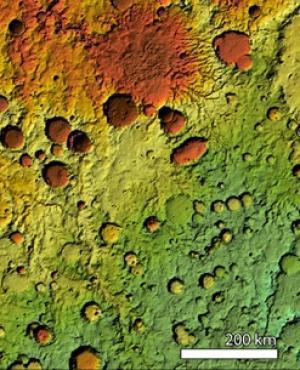Floods follow a period of formation of a valley network on Mars
A new study shows that ancient features on the surface of Mars, known as the valley network, are caused by periodic floods during long periods when the Martian climate has the same conditions as dry areas. term, less rain on Earth. Accordingly, the hypothesis is that the valleys formed by catastrophic flooding for a relatively short time did not match the results obtained.
Often cited as evidence for the once-warm Martian climate with liquid water on the surface, the valley network is a distinctive feature of the landscape on Mars. In the new study, researchers used a modern computer model to reproduce the process of creating that trait. Charles Barnhart, an Earth and planetary graduate student at the University of California, Santa Cruz, said: 'Our study provides a view of the stable existence of liquid water on the surface of Mars. in the long time in the past '.
Barnhart conducted research as a scholar of the Ames Research Center's Fellowship Program (NASA), in collaboration with planetary scientist Jeffre Moore (NASA) and University of Alan Howard. Virginia. The article published the results of their research, which was published in Geophysical Research - Planets, which is now available online.
Moore said: 'For several decades scientists have been working hard to find out if rain exists or not on Mars. In the past 10 years, NASA has obtained a lot of high-resolution terrain image data enough to confirm that there has been a large-scale ancient erosion caused by rain. ' Scientists estimate that the valley network on Mars formed about 3.5 million years ago. Research based on climate models also shows that catastrophic phenomena such as meteorite collisions may also have created a warm and humid climate on Mars, thereby triggering cataclysmic battles. sink Mars for hundreds to thousands of years.

Ancient terrain characteristics like rivers and streams are essentially valley networks on the surface of Mars.The valley system intersects an area of the size of California state.(Photo: Image courtesy of University of California - Santa Cruz)
According to Barnhart, the new study shows that the conditions above form the unobservable features on the Martian surface; because water accumulates in craters and escapes, forming a drainage hole through the crater wall.
'Our research found that unusual catastrophic events create a humid environment, so there will be holes in the crater that we cannot observe. Seasonal or seasonal precipitation is required to have adequate evaporation and accumulation time. Otherwise water in the craters will overflow '.
The researchers used a ground-based transformation model to replicate the process of changing the surface of Mars under different climatic conditions. They conducted over 70 simulations with varying conditions and conducted a statistical analysis to determine which model is most suitable for the valley-filled terrain on Mars today.
The results show that the valley network formed on Mars during dry climates, lack of rain persists for tens of thousands of years to hundreds of thousands of years. Stage flooding also changes with the dry period - the time when water can evaporate or seep into rocky ground. Rainfall is probably also periodic, the period between two wet climates probably also occurs with longer periods. But the conditions that allow the existence of liquid water on the surface of Mars have certainly existed for at least 10,000 years.
Barnhart said: 'The rain on Mars has been going on for a long time, it is not a short break between cataclysms'.
- Mars used to have rain
- More evidence that Mars had life
- Learn LinkedIn, the recruiting network that made Microsoft spend 26.2 billion dollars to buy back
- 7 'Mars' lands on Earth
- Impressive images on Mars
- Revealing the reason why Mars kept water in the lake
- City projects on Mars are about to be built
- NASA is about to launch new Mars explorer robots: Find alien life
- Learn the secret of Mars formation
- Climate change due to 10 million-year greenhouse effect on Mars
- Revealing the cause of Mars without the atmosphere
- Instructions on how to get rid of safe flash floods
 Van Allen's belt and evidence that the Apollo 11 mission to the Moon was myth
Van Allen's belt and evidence that the Apollo 11 mission to the Moon was myth The levels of civilization in the universe (Kardashev scale)
The levels of civilization in the universe (Kardashev scale) Today Mars, the sun and the Earth are aligned
Today Mars, the sun and the Earth are aligned The Amazon owner announced a secret plan to build a space base for thousands of people
The Amazon owner announced a secret plan to build a space base for thousands of people